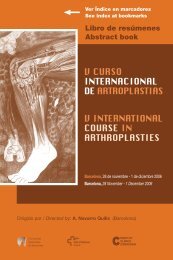Notas / Notes - Active Congress.......
Notas / Notes - Active Congress.......
Notas / Notes - Active Congress.......
Create successful ePaper yourself
Turn your PDF publications into a flip-book with our unique Google optimized e-Paper software.
MIÉRCOLES / WEDNESDAY<br />
64<br />
TOTAL HIP REPLACEMENT WITH ALL<br />
ALUMINA BEARINGS IN PATIENTS UNDER<br />
30 YEARS OF AGE<br />
Laurent Sedel, Remy. Nizard, Agnes Raoult , Damien<br />
Pourreyron, Frederic Zadegan.<br />
Hopital Lariboisière, APHP , University Denis Diderot,<br />
Paris (France)<br />
Total hip arthroplasty in very young age is very challenging<br />
due to long term expectancy necessary at this age, and also<br />
due to special aetiology in this group of patients; Anatomical<br />
difficulties at the femur and at the acetabulum side are<br />
frequent.<br />
Alumina on alumina sliding couple was introduced to address<br />
the problem of macrophagic reaction to wear debris. Then<br />
this material is particularly dedicated to young and active<br />
patients. We looked retrospectively at this category of patients<br />
in order to see if this choice was right.<br />
MATERIALS AND METHODS<br />
From a population of more than 4500 total hips implanted<br />
with an all alumina bearings couple we selected 132 prostheses<br />
in 101 patients aged less than 30 years at time of<br />
operation. These prostheses were implanted consecutively<br />
since September 1979. Fifty nine males, 42 females, mean<br />
age was 23 (12 to 30).<br />
Avascular necrosis was the more frequent aetiology: 64<br />
cases (51 steroid induced), followed by inflammatory diseases:<br />
18, postrauma: 18, sequellae of infection in the newborn<br />
10, slipped capital epiphysis in 12, miscellaneous in 10 (sickle<br />
cell anaemia, tumours, agenesis of the femur) .Twenty four<br />
hips had had some previous procedure.<br />
Regarding the implanted material, the stem (Ceraver Osteal*)<br />
was cemented 62 times and uncemented in 70. there was<br />
5 different alumina socket fixation systems: 10 bulky cemented,<br />
22 bulky cementless, 6 with a screw in titanium cup and<br />
alumina liner, 14 press fit titanium shell covered with a<br />
titanium mesh, and 80 comparable but with an outer surface<br />
rough and covered with hydroxyapatite... Alumina head was<br />
always 32 mm in diameter except one and all prostheses<br />
had an alumina on alumina couple.<br />
RESULTS<br />
Six patients (8 hips) deceased, 17 hips were revised at a<br />
mean of 9 years postop. leaving 107 hips with a 7 years<br />
mean follow-up (1 to 27 years). Socket revisions were<br />
performed 12 times, femur was revised twice and bipolar<br />
revision 3 times (two for sepsis). Regarding the 107 hips still<br />
in place, clinical results ( regarding Postel Merle D’Aubigné<br />
rating system) was excellent or very good ((16 to 18)) in 97,<br />
good (13 to 15) in 9 and fair or bad in1. four became pregnant<br />
without problems. Roentgenographic results, 7 had some<br />
radio lucent lines, one was complete . On the femur side, 10<br />
had limited osteolytic lesion always on cemented stem and<br />
in zone 7 (Gruen). Survivorship analysis depicted 82% survivors<br />
at 10 years and 72% at 14 years. Interestingly enough<br />
infection, avn (with the exception of sickle cell disease) and<br />
inflammatory diseases did better than trauma or slipped<br />
capital epiphysis. .<br />
DISCUSSION AND CONCLUSION<br />
In a difficult series of patients under the age of 30 years, the<br />
results of alumina on alumina total hip were satisfactory.<br />
Most of the failures were related to surgical difficulties. Socket<br />
fixation system was not optimised at the beginning explaining<br />
the high rate of acetabular component loosening. There was<br />
also a tendency for some aetiologies to give bad results, this<br />
was the case for sickle cell disease ((3 failures out of 8) and<br />
for slipped capital epiphysis (3 out of 12). Last cementless<br />
design markedly improved prosthesis stability. Socket<br />
revisions were relatively easy and limited to this component.<br />
Interestingly enough, previous infected cases (10 cases)<br />
were not complicated with infection recurrence in this series.<br />
PROTESIS TOTAL DE CADERA Y<br />
ENFERMEDAD DISPLÁSICA DE CADERA<br />
A. Murcia Mazón. M. Fernández Fairén, RP. García Díaz.<br />
Universidades de Oviedo y Politécnica de Cataluña,<br />
Hospital de Cabueñes, Gijón (Spain)<br />
INTRODUCCIÓN<br />
La displasia de cadera en el adulto (DCA) es secundaria a<br />
la enfermedad luxante de la cadera durante la época de<br />
crecimiento. Suele tratarse de una forma de displasia residual,<br />
que afecta a la articulación y que es responsable de una<br />
artrosis precoz y cuya frecuencia oscila entre el 25 y 50%<br />
de los menores de 50 años 1 . En otras ocasiones la DCA se<br />
descubre con motivo de un estudio Radiológico por otra<br />
patología 2 .<br />
INDICACIONES<br />
La artroplastia total de cadera (ATC) en una DCA es una<br />
intervención difícil y para conseguir un cotilo cubierto por<br />
completo por hueso es necesario implantarlo en su sitio<br />
original 3 con frecuencia realizar una osteotomía subtrocantérica<br />
de acortamiento.<br />
La planificación de la ATC en una displasia exige establecer<br />
una clasificación donde la altura en que se encuentra la<br />
cabeza femoral es más importante que determinados ángulos





